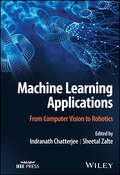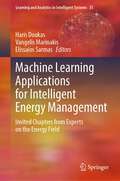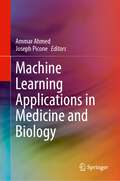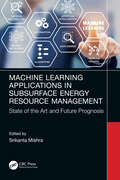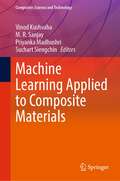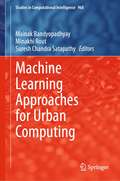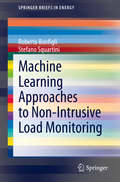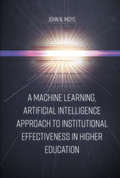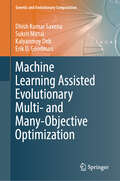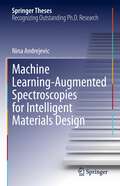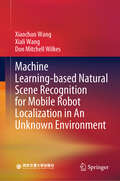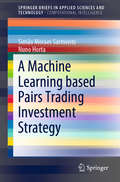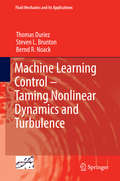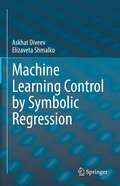- Table View
- List View
Machine Learning Applications: From Computer Vision to Robotics
by Indranath Chatterjee Sheetal ZalteMachine Learning Applications Practical resource on the importance of Machine Learning and Deep Learning applications in various technologies and real-world situations Machine Learning Applications discusses methodological advancements of machine learning and deep learning, presents applications in image processing, including face and vehicle detection, image classification, object detection, image segmentation, and delivers real-world applications in healthcare to identify diseases and diagnosis, such as creating smart health records and medical imaging diagnosis, and provides real-world examples, case studies, use cases, and techniques to enable the reader’s active learning. Composed of 13 chapters, this book also introduces real-world applications of machine and deep learning in blockchain technology, cyber security, and climate change. An explanation of AI and robotic applications in mechanical design is also discussed, including robot-assisted surgeries, security, and space exploration. The book describes the importance of each subject area and detail why they are so important to us from a societal and human perspective. Edited by two highly qualified academics and contributed to by established thought leaders in their respective fields, Machine Learning Applications includes information on: Content based medical image retrieval (CBMIR), covering face and vehicle detection, multi-resolution and multisource analysis, manifold and image processing, and morphological processing Smart medicine, including machine learning and artificial intelligence in medicine, risk identification, tailored interventions, and association rules AI and robotics application for transportation and infrastructure (e.g., autonomous cars and smart cities), along with global warming and climate change Identifying diseases and diagnosis, drug discovery and manufacturing, medical imaging diagnosis, personalized medicine, and smart health records With its practical approach to the subject, Machine Learning Applications is an ideal resource for professionals working with smart technologies such as machine and deep learning, AI, IoT, and other wireless communications; it is also highly suitable for professionals working in robotics, computer vision, cyber security and more.
Machine Learning Applications: From Computer Vision to Robotics
by Indranath Chatterjee Sheetal ZalteMachine Learning Applications Practical resource on the importance of Machine Learning and Deep Learning applications in various technologies and real-world situations Machine Learning Applications discusses methodological advancements of machine learning and deep learning, presents applications in image processing, including face and vehicle detection, image classification, object detection, image segmentation, and delivers real-world applications in healthcare to identify diseases and diagnosis, such as creating smart health records and medical imaging diagnosis, and provides real-world examples, case studies, use cases, and techniques to enable the reader’s active learning. Composed of 13 chapters, this book also introduces real-world applications of machine and deep learning in blockchain technology, cyber security, and climate change. An explanation of AI and robotic applications in mechanical design is also discussed, including robot-assisted surgeries, security, and space exploration. The book describes the importance of each subject area and detail why they are so important to us from a societal and human perspective. Edited by two highly qualified academics and contributed to by established thought leaders in their respective fields, Machine Learning Applications includes information on: Content based medical image retrieval (CBMIR), covering face and vehicle detection, multi-resolution and multisource analysis, manifold and image processing, and morphological processing Smart medicine, including machine learning and artificial intelligence in medicine, risk identification, tailored interventions, and association rules AI and robotics application for transportation and infrastructure (e.g., autonomous cars and smart cities), along with global warming and climate change Identifying diseases and diagnosis, drug discovery and manufacturing, medical imaging diagnosis, personalized medicine, and smart health records With its practical approach to the subject, Machine Learning Applications is an ideal resource for professionals working with smart technologies such as machine and deep learning, AI, IoT, and other wireless communications; it is also highly suitable for professionals working in robotics, computer vision, cyber security and more.
Machine Learning Applications for Intelligent Energy Management: Invited Chapters from Experts on the Energy Field (Learning and Analytics in Intelligent Systems #35)
by Haris Doukas Vangelis Marinakis Elissaios SarmasAs carbon dioxide (CO2) emissions and other greenhouse gases constantly rise and constitute the main contributor to climate change, temperature rise and global warming, artificial intelligence, big data, Internet of things, and blockchain technologies are enlisted to help enforce energy transition and transform the entire energy sector. The book at hand presents state-of-the-art developments in artificial intelligence-empowered analytics of energy data and artificial intelligence-empowered application development. Topics covered include a presentation of the various stakeholders in the energy sector and their corresponding required analytic services, such as state-of-the-art machine learning, artificial intelligence, and optimization models and algorithms tailored for a series of demanding energy problems and aiming at providing optimal solutions under specific constraints. Professors, researchers, scientists, engineers, and students in energy sector-related disciplines are expected to be inspired and benefit from this book, along with readers from other disciplines wishing to learn more about this exciting new field of research.
Machine Learning Applications in Electronic Design Automation
by Haoxing Ren Jiang HuThis book serves as a single-source reference to key machine learning (ML) applications and methods in digital and analog design and verification. Experts from academia and industry cover a wide range of the latest research on ML applications in electronic design automation (EDA), including analysis and optimization of digital design, analysis and optimization of analog design, as well as functional verification, FPGA and system level designs, design for manufacturing (DFM), and design space exploration. The authors also cover key ML methods such as classical ML, deep learning models such as convolutional neural networks (CNNs), graph neural networks (GNNs), generative adversarial networks (GANs) and optimization methods such as reinforcement learning (RL) and Bayesian optimization (BO). All of these topics are valuable to chip designers and EDA developers and researchers working in digital and analog designs and verification.
Machine Learning Applications in Medicine and Biology
by Ammar Ahmed Joseph PiconeThis book combines selected papers from the 2022 IEEE Signal Processing in Medicine and Biology Symposium (IEEE SPMB) held at Temple University. The symposium presents multidisciplinary research in the life sciences. Topics covered include:Signal and image analysis (EEG, ECG, MRI)Machine learningData mining and classificationBig data resourcesApplications of particular interest at the 2022 symposium included digital pathology, computational biology, and quantum computing. The book features tutorials and examples of successful applications that will appeal to a wide range of professionals and researchers in signal processing, medicine, and biology.
Machine Learning Applications in Subsurface Energy Resource Management: State of the Art and Future Prognosis
by Srikanta MishraThe utilization of machine learning (ML) techniques to understand hidden patterns and build data-driven predictive models from complex multivariate datasets is rapidly increasing in many applied science and engineering disciplines, including geo-energy. Motivated by these developments, Machine Learning Applications in Subsurface Energy Resource Management presents a current snapshot of the state of the art and future outlook for ML applications to manage subsurface energy resources (e.g., oil and gas, geologic carbon sequestration, and geothermal energy). Covers ML applications across multiple application domains (reservoir characterization, drilling, production, reservoir modeling, and predictive maintenance) Offers a variety of perspectives from authors representing operating companies, universities, and research organizations Provides an array of case studies illustrating the latest applications of several ML techniques Includes a literature review and future outlook for each application domain This book is targeted at practicing petroleum engineers or geoscientists interested in developing a broad understanding of ML applications across several subsurface domains. It is also aimed as a supplementary reading for graduate-level courses and will also appeal to professionals and researchers working with hydrogeology and nuclear waste disposal.
Machine Learning Applications in Subsurface Energy Resource Management: State of the Art and Future Prognosis
by Srikanta MishraThe utilization of machine learning (ML) techniques to understand hidden patterns and build data-driven predictive models from complex multivariate datasets is rapidly increasing in many applied science and engineering disciplines, including geo-energy. Motivated by these developments, Machine Learning Applications in Subsurface Energy Resource Management presents a current snapshot of the state of the art and future outlook for ML applications to manage subsurface energy resources (e.g., oil and gas, geologic carbon sequestration, and geothermal energy). Covers ML applications across multiple application domains (reservoir characterization, drilling, production, reservoir modeling, and predictive maintenance) Offers a variety of perspectives from authors representing operating companies, universities, and research organizations Provides an array of case studies illustrating the latest applications of several ML techniques Includes a literature review and future outlook for each application domain This book is targeted at practicing petroleum engineers or geoscientists interested in developing a broad understanding of ML applications across several subsurface domains. It is also aimed as a supplementary reading for graduate-level courses and will also appeal to professionals and researchers working with hydrogeology and nuclear waste disposal.
Machine Learning Applied to Composite Materials (Composites Science and Technology)
by Vinod Kushvaha M. R. Sanjay Priyanka Madhushri Suchart SiengchinThis book introduces the approach of Machine Learning (ML) based predictive models in the design of composite materials to achieve the required properties for certain applications. ML can learn from existing experimental data obtained from very limited number of experiments and subsequently can be trained to find solutions of the complex non-linear, multi-dimensional functional relationships without any prior assumptions about their nature. In this case the ML models can learn from existing experimental data obtained from (1) composite design based on various properties of the matrix material and fillers/reinforcements (2) material processing during fabrication (3) property relationships. Modelling of these relationships using ML methods significantly reduce the experimental work involved in designing new composites, and therefore offer a new avenue for material design and properties. The book caters to students, academics and researchers who are interested in the field of material composite modelling and design.
Machine Learning Approaches and Applications in Applied Intelligence for Healthcare Data Analytics (Innovations in Big Data and Machine Learning)
by Abhishek Kumar, Ashutosh Kumar Dubey, Sreenatha G. Anavatti and Pramod Singh RathoreIn the last two decades, machine learning has developed dramatically and is still experiencing a fast and everlasting change in paradigms, methodology, applications and other aspects. This book offers a compendium of current and emerging machine learning paradigms in healthcare informatics and reflects on their diversity and complexity. Machine Learning Approaches and Applications in Applied Intelligence for Healthcare Data Analytics presents a variety of techniques designed to enhance and empower multi-disciplinary and multi-institutional machine learning research. It provides many case studies and a panoramic view of data and machine learning techniques, providing the opportunity for novel insights and discoveries. The book explores the theory and practical applications in healthcare and includes a guided tour of machine learning algorithms, architecture design and interdisciplinary challenges. This book is useful for research scholars and students involved in critical condition analysis and computation models.
Machine Learning Approaches and Applications in Applied Intelligence for Healthcare Data Analytics (Innovations in Big Data and Machine Learning)
by Abhishek Kumar Ashutosh Kumar Dubey Sreenatha G. Anavatti Pramod Singh RathoreIn the last two decades, machine learning has developed dramatically and is still experiencing a fast and everlasting change in paradigms, methodology, applications and other aspects. This book offers a compendium of current and emerging machine learning paradigms in healthcare informatics and reflects on their diversity and complexity. Machine Learning Approaches and Applications in Applied Intelligence for Healthcare Data Analytics presents a variety of techniques designed to enhance and empower multi-disciplinary and multi-institutional machine learning research. It provides many case studies and a panoramic view of data and machine learning techniques, providing the opportunity for novel insights and discoveries. The book explores the theory and practical applications in healthcare and includes a guided tour of machine learning algorithms, architecture design and interdisciplinary challenges. This book is useful for research scholars and students involved in critical condition analysis and computation models.
Machine Learning Approaches for Urban Computing (Studies in Computational Intelligence #968)
by Mainak Bandyopadhyay Minakhi Rout Suresh Chandra SatapathyThis book discusses various machine learning applications and models, developed using heterogeneous data, which helps in a comprehensive prediction, optimization, association analysis, cluster analysis and classification-related applications for various activities in urban area. It details multiple types of data generating from urban activities and suitability of various machine learning algorithms for handling urban data. The book is helpful for researchers, academicians, faculties, scientists and geospatial industry professionals for their research work and sets new ideas in the field of urban computing.
Machine Learning Approaches in Financial Analytics (Intelligent Systems Reference Library #254)
by Leandros A. Maglaras Sonali Das Naliniprava Tripathy Srikanta PatnaikThis book addresses the growing need for a comprehensive guide to the application of machine learning in financial analytics. It offers a valuable resource for both beginners and experienced professionals in finance and data science by covering the theoretical foundations, practical implementations, ethical considerations, and future trends in the field. It bridges the gap between theory and practice, providing readers with the tools and knowledge they need to leverage the power of machine learning in the financial sector responsibly.
Machine Learning Approaches to Non-Intrusive Load Monitoring (SpringerBriefs in Energy)
by Roberto Bonfigli Stefano SquartiniResearch on Smart Grids has recently focused on the energy monitoring issue, with the objective of maximizing the user consumption awareness in building contexts on the one hand, and providing utilities with a detailed description of customer habits on the other. In particular, Non-Intrusive Load Monitoring (NILM), the subject of this book, represents one of the hottest topics in Smart Grid applications. NILM refers to those techniques aimed at decomposing the consumption-aggregated data acquired at a single point of measurement into the diverse consumption profiles of appliances operating in the electrical system under study. This book provides a status report on the most promising NILM methods, with an overview of the publically available dataset on which the algorithm and experiments are based. Of the proposed methods, those based on the Hidden Markov Model (HMM) and the Deep Neural Network (DNN) are the best performing and most interesting from the future improvement point of view. One method from each category has been selected and the performance improvements achieved are described. Comparisons are made between the two reference techniques, and pros and cons are considered. In addition, performance improvements can be achieved when the reactive power component is exploited in addition to the active power consumption trace.
A Machine Learning, Artificial Intelligence Approach to Institutional Effectiveness in Higher Education
by John N. MoyeThe Institutional Research profession is currently experimenting with many strategies to assess institutional effectiveness in a manner that reflects the letter and spirit of their unique mission, vision, and values. While a "best-practices" approach to the measurement and assessment of institutional functions is prevalent in the literature, a machine learning approach that synthesizes these parts into a coherent and synergistic approach has not emerged. A Machine Learning, Artificial Intelligence Approach to Institutional Effectiveness in Higher Education presents a practical, effective, and systematic approach to the measurement, assessment, and sensemaking of institutional performance. Included are instruments and strategies to measure and assess the performance of Curriculum, Learning, Instruction, Support Services, and Program Feasibility as well as a meaningful Environmental Scanning method. The data collected in this system are organized into assessments of institutional effectiveness through the application of machine learning data processes that create an artificial intelligence model of actual institutional performance from the raw performance data. This artificial intelligence is visualized through five organizational sensemaking approaches to monitor, demonstrate, and improve institutional performance. Thus, this book provides a set of tools that can be adopted or adapted to the specific intentions of any institution, making it an invaluable resource for Higher Education administrators, leaders and practitioners.
A Machine Learning, Artificial Intelligence Approach to Institutional Effectiveness in Higher Education
by John N. MoyeThe Institutional Research profession is currently experimenting with many strategies to assess institutional effectiveness in a manner that reflects the letter and spirit of their unique mission, vision, and values. While a "best-practices" approach to the measurement and assessment of institutional functions is prevalent in the literature, a machine learning approach that synthesizes these parts into a coherent and synergistic approach has not emerged. A Machine Learning, Artificial Intelligence Approach to Institutional Effectiveness in Higher Education presents a practical, effective, and systematic approach to the measurement, assessment, and sensemaking of institutional performance. Included are instruments and strategies to measure and assess the performance of Curriculum, Learning, Instruction, Support Services, and Program Feasibility as well as a meaningful Environmental Scanning method. The data collected in this system are organized into assessments of institutional effectiveness through the application of machine learning data processes that create an artificial intelligence model of actual institutional performance from the raw performance data. This artificial intelligence is visualized through five organizational sensemaking approaches to monitor, demonstrate, and improve institutional performance. Thus, this book provides a set of tools that can be adopted or adapted to the specific intentions of any institution, making it an invaluable resource for Higher Education administrators, leaders and practitioners.
Machine Learning Assisted Evolutionary Multi- and Many- Objective Optimization (Genetic and Evolutionary Computation)
by Dhish Kumar Saxena Sukrit Mittal Kalyanmoy Deb Erik D. GoodmanThis book focuses on machine learning (ML) assisted evolutionary multi- and many-objective optimization (EMâO). EMâO algorithms, namely EMâOAs, iteratively evolve a set of solutions towards a good Pareto Front approximation. The availability of multiple solution sets over successive generations makes EMâOAs amenable to application of ML for different pursuits. Recognizing the immense potential for ML-based enhancements in the EMâO domain, this book intends to serve as an exclusive resource for both domain novices and the experienced researchers and practitioners. To achieve this goal, the book first covers the foundations of optimization, including problem and algorithm types. Then, well-structured chapters present some of the key studies on ML-based enhancements in the EMâO domain, systematically addressing important aspects. These include learning to understand the problem structure, converge better, diversify better, simultaneously converge and diversify better, and analyze the Pareto Front. In doing so, this book broadly summarizes the literature, beginning with foundational work on innovization (2003) and objective reduction (2006), and extending to the most recently proposed innovized progress operators (2021-23). It also highlights the utility of ML interventions in the search, post-optimality, and decision-making phases pertaining to the use of EMâOAs. Finally, this book shares insightful perspectives on the future potential for ML based enhancements in the EMâOA domain.To aid readers, the book includes working codes for the developed algorithms. This book will not only strengthen this emergent theme but also encourage ML researchers to develop more efficient and scalable methods that cater to the requirements of the EMâOA domain. It serves as an inspiration for further research and applications at the synergistic intersection of EMâOA and ML domains.
Machine Learning-Augmented Spectroscopies for Intelligent Materials Design (Springer Theses)
by Nina AndrejevicThe thesis contains several pioneering results at the intersection of state-of-the-art materials characterization techniques and machine learning. The use of machine learning empowers the information extraction capability of neutron and photon spectroscopies. In particular, new knowledge and new physics insights to aid spectroscopic analysis may hold great promise for next-generation quantum technology. As a prominent example, the so-called proximity effect at topological material interfaces promises to enable spintronics without energy dissipation and quantum computing with fault tolerance, yet the characteristic spectral features to identify the proximity effect have long been elusive. The work presented within permits a fine resolution of its spectroscopic features and a determination of the proximity effect which could aid further experiments with improved interpretability. A few novel machine learning architectures are proposed in this thesis work which leverage the case when the data is scarce and utilize the internal symmetry of the system to improve the training quality. The work sheds light on future pathways to apply machine learning to augment experiments.
Machine Learning-based Design and Optimization of High-Speed Circuits
by Vazgen MelikyanThis book describes machine learning-based new principles, methods of design and optimization of high-speed integrated circuits, included in one electronic system, which can exchange information between each other up to 128/256/512 Gbps speed. The efficiency of methods has been proven and is described on the examples of practical designs. This will enable readers to use them in similar electronic system designs. The author demonstrates newly developed principles and methods to accelerate communication between ICs, working in non-standard operating conditions, considering signal deviation compensation with linearity self-calibration. The observed circuit types also include but are not limited to mixed-signal, high performance heterogeneous integrated circuits as well as digital cores.
Machine Learning-Based Modelling in Atomic Layer Deposition Processes (Emerging Materials and Technologies)
by Oluwatobi Adeleke Sina Karimzadeh Tien-Chien JenWhile thin film technology has benefited greatly from artificial intelligence (AI) and machine learning (ML) techniques, there is still much to be learned from a full-scale exploration of these technologies in atomic layer deposition (ALD). This book provides in-depth information regarding the application of ML-based modeling techniques in thin film technology as a standalone approach and integrated with the classical simulation and modeling methods. It is the first of its kind to present detailed information regarding approaches in ML-based modeling, optimization, and prediction of the behaviors and characteristics of ALD for improved process quality control and discovery of new materials. As such, this book fills significant knowledge gaps in the existing resources as it provides extensive information on ML and its applications in film thin technology. Offers an in-depth overview of the fundamentals of thin film technology, state-of-the-art computational simulation approaches in ALD, ML techniques, algorithms, applications, and challenges. Establishes the need for and significance of ML applications in ALD while introducing integration approaches for ML techniques with computation simulation approaches. Explores the application of key techniques in ML, such as predictive analysis, classification techniques, feature engineering, image processing capability, and microstructural analysis of deep learning algorithms and generative model benefits in ALD. Helps readers gain a holistic understanding of the exciting applications of ML-based solutions to ALD problems and apply them to real-world issues. Aimed at materials scientists and engineers, this book fills significant knowledge gaps in existing resources as it provides extensive information on ML and its applications in film thin technology. It also opens space for future intensive research and intriguing opportunities for ML-enhanced ALD processes, which scale from academic to industrial applications. . .
Machine Learning-Based Modelling in Atomic Layer Deposition Processes (Emerging Materials and Technologies)
by Oluwatobi Adeleke Sina Karimzadeh Tien-Chien JenWhile thin film technology has benefited greatly from artificial intelligence (AI) and machine learning (ML) techniques, there is still much to be learned from a full-scale exploration of these technologies in atomic layer deposition (ALD). This book provides in-depth information regarding the application of ML-based modeling techniques in thin film technology as a standalone approach and integrated with the classical simulation and modeling methods. It is the first of its kind to present detailed information regarding approaches in ML-based modeling, optimization, and prediction of the behaviors and characteristics of ALD for improved process quality control and discovery of new materials. As such, this book fills significant knowledge gaps in the existing resources as it provides extensive information on ML and its applications in film thin technology. Offers an in-depth overview of the fundamentals of thin film technology, state-of-the-art computational simulation approaches in ALD, ML techniques, algorithms, applications, and challenges. Establishes the need for and significance of ML applications in ALD while introducing integration approaches for ML techniques with computation simulation approaches. Explores the application of key techniques in ML, such as predictive analysis, classification techniques, feature engineering, image processing capability, and microstructural analysis of deep learning algorithms and generative model benefits in ALD. Helps readers gain a holistic understanding of the exciting applications of ML-based solutions to ALD problems and apply them to real-world issues. Aimed at materials scientists and engineers, this book fills significant knowledge gaps in existing resources as it provides extensive information on ML and its applications in film thin technology. It also opens space for future intensive research and intriguing opportunities for ML-enhanced ALD processes, which scale from academic to industrial applications. . .
Machine Learning-based Natural Scene Recognition for Mobile Robot Localization in An Unknown Environment
by Xiaochun Wang Xiali Wang Don Mitchell WilkesThis book advances research on mobile robot localization in unknown environments by focusing on machine-learning-based natural scene recognition. The respective chapters highlight the latest developments in vision-based machine perception and machine learning research for localization applications, and cover such topics as: image-segmentation-based visual perceptual grouping for the efficient identification of objects composing unknown environments; classification-based rapid object recognition for the semantic analysis of natural scenes in unknown environments; the present understanding of the Prefrontal Cortex working memory mechanism and its biological processes for human-like localization; and the application of this present understanding to improve mobile robot localization. The book also features a perspective on bridging the gap between feature representations and decision-making using reinforcement learning, laying the groundwork for future advances in mobile robot navigation research.
A Machine Learning based Pairs Trading Investment Strategy (SpringerBriefs in Applied Sciences and Technology)
by Simão Moraes Sarmento Nuno HortaThis book investigates the application of promising machine learning techniques to address two problems: (i) how to find profitable pairs while constraining the search space and (ii) how to avoid long decline periods due to prolonged divergent pairs. It also proposes the integration of an unsupervised learning algorithm, OPTICS, to handle problem (i), and demonstrates that the suggested technique can outperform the common pairs search methods, achieving an average portfolio Sharpe ratio of 3.79, in comparison to 3.58 and 2.59 obtained using standard approaches. For problem (ii), the authors introduce a forecasting-based trading model capable of reducing the periods of portfolio decline by 75%. However, this comes at the expense of decreasing overall profitability. The authors also test the proposed strategy using an ARMA model, an LSTM and an LSTM encoder-decoder.
Machine Learning-based Prediction of Missing Parts for Assembly (Findings from Production Management Research)
by Fabian SteinbergManufacturing companies face challenges in managing increasing process complexity while meeting demands for on-time delivery, particularly evident during critical processes like assembly. The early identification of potential missing parts at the beginning assembly emerges as a crucial strategy to uphold delivery commitments. This book embarks on developing machine learning-based prediction models to tackle this challenge. Through a systemic literature review, deficiencies in current predictive methodologies are highlighted, notably the underutilization of material data and a late prediction capability within the procurement process. Through case studies within the machine industry a significant influence of material data on the quality of models predicting missing parts from in-house production was verified. Further, a model for predicting delivery delays in the purchasing process was implemented, which makes it possible to predict potential missing parts from suppliers at the time of ordering. These advancements serve as indispensable tools for production planners and procurement professionals, empowering them to proactively address material availability challenges for assembly operations.
Machine Learning Control – Taming Nonlinear Dynamics and Turbulence: Taming Nonlinear Dynamics And Turbulence (Fluid Mechanics and Its Applications #116)
by Thomas Duriez Steven L. Brunton Bernd R. NoackThis is the first textbook on a generally applicable control strategy for turbulence and other complex nonlinear systems. The approach of the book employs powerful methods of machine learning for optimal nonlinear control laws. This machine learning control (MLC) is motivated and detailed in Chapters 1 and 2. In Chapter 3, methods of linear control theory are reviewed. In Chapter 4, MLC is shown to reproduce known optimal control laws for linear dynamics (LQR, LQG). In Chapter 5, MLC detects and exploits a strongly nonlinear actuation mechanism of a low-dimensional dynamical system when linear control methods are shown to fail. Experimental control demonstrations from a laminar shear-layer to turbulent boundary-layers are reviewed in Chapter 6, followed by general good practices for experiments in Chapter 7. The book concludes with an outlook on the vast future applications of MLC in Chapter 8. Matlab codes are provided for easy reproducibility of the presented results. The book includes interviews with leading researchers in turbulence control (S. Bagheri, B. Batten, M. Glauser, D. Williams) and machine learning (M. Schoenauer) for a broader perspective. All chapters have exercises and supplemental videos will be available through YouTube.
Machine Learning Control by Symbolic Regression
by Askhat Diveev Elizaveta ShmalkoThis book provides comprehensive coverage on a new direction in computational mathematics research: automatic search for formulas. Formulas must be sought in all areas of science and life: these are the laws of the universe, the macro and micro world, fundamental physics, engineering, weather and natural disasters forecasting; the search for new laws in economics, politics, sociology. Accumulating many years of experience in the development and application of numerical methods of symbolic regression to solving control problems, the authors offer new possibilities not only in the field of control automation, but also in the design of completely different optimal structures in many fields. For specialists in the field of control, Machine Learning Control by Symbolic Regression opens up a new promising direction of research and acquaints scientists with the methods of automatic construction of control systems.For specialists in the field of machine learning, the book opens up a new, much broader direction than neural networks: methods of symbolic regression. This book makes it easy to master this new area in machine learning and apply this approach everywhere neural networks are used. For mathematicians, the book opens up a new approach to the construction of numerical methods for obtaining analytical solutions to unsolvable problems; for example, numerical analytical solutions of algebraic equations, differential equations, non-trivial integrals, etc. For specialists in the field of artificial intelligence, the book offers a machine way to solve problems, framed in the form of analytical relationships.
